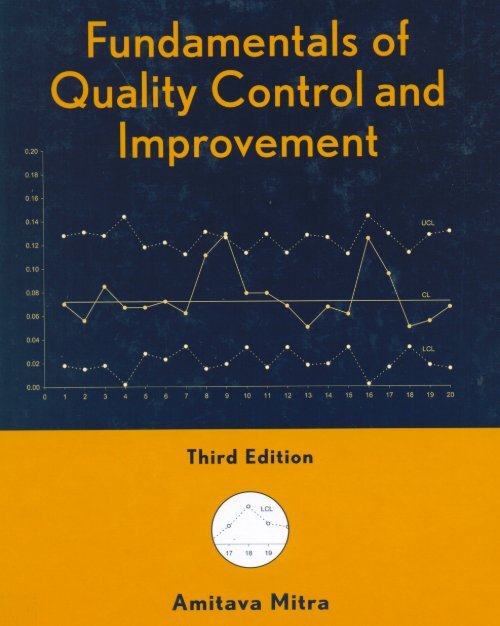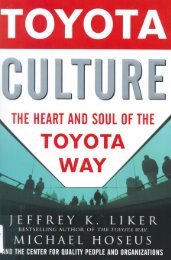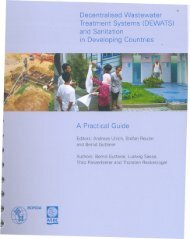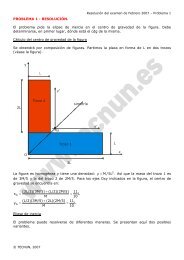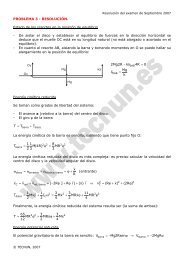Amitava Mitra - Tecnun
Amitava Mitra - Tecnun
Amitava Mitra - Tecnun
You also want an ePaper? Increase the reach of your titles
YUMPU automatically turns print PDFs into web optimized ePapers that Google loves.
Third<br />
Edition<br />
<strong>Amitava</strong><br />
<strong>Mitra</strong>
PREFACE<br />
xix<br />
PART1 PHILOSOPHYAND FUNDAMENTALS 1<br />
1 Introductionto Quality Control and the Total Quality System<br />
3<br />
1-1 Introductionand Chapter Objectives, 3<br />
1-2 Evolutionof Quality Control, 4<br />
1-3 Quality, 7<br />
Quality Characteristics, 8<br />
Variablesand Attributes, 8<br />
Defects, 9<br />
Standard or Specification, 9<br />
Quality of Design, 9<br />
Quality of Conformance, 10<br />
Quality of Performance, 11<br />
1-4 QualityControl, 11<br />
Off-Line Quality Control, 12<br />
Statistical Process Control, 12<br />
Acceptance Sampling Plans, 12<br />
1-5 Quality Assurance, 13<br />
1-6 Quality Circ1esand Quality Improvement Teams, 14<br />
1-7 Customer Needs and Market Share, 15<br />
Kano Model, 15<br />
1-8 Benefitsof Quality Control and the Total Quality System, 16<br />
Total Quality System, 17<br />
1-9 Quality and Reliability, 17<br />
1-10 QualityImprovement, 18<br />
1-11 Product and Service Costing, 19<br />
Activity-Based Costing, 19<br />
1-12 Quality Costs, 22<br />
Prevention Costs, 23<br />
Appraisal Costs, 23
Internal Failure Costs, 23<br />
External Failure Costs, 24<br />
Hidden Failure Costs, 24<br />
Quality Costs Data Requirements, 24<br />
Proeess Cost Approaeh, 25<br />
1-13 Measuring Quality Costs, 26<br />
Impaet of Quality Improvement on Quality Costs, 28<br />
1-14 Management of Quality, 30<br />
1-15 Quality and Produetivity, 33<br />
Effeet on Cost, 33<br />
Effeet on Market, 33<br />
1-16 Total Quality Environmental Management, 36<br />
1-17 Profile of a Company: The Bama Companies, Ine., 37<br />
Company History and Vision, 37<br />
Eyes on Quality, 38<br />
The Future Looks Bright, 38<br />
Innovation and Quality Improvement, 38<br />
People Make the Company, 39<br />
Summary, 39<br />
Key Terms, 40<br />
Exercises, 40<br />
Referenees, 44<br />
2 Some Philosophies aod Their Impact 00 Quality<br />
47<br />
2-1 Introduetion and Chapter Objeetives, 47<br />
2-2 Serviee Industries and Their Charaeteristies, 48<br />
Differenees in the Manufaeturing and Serviee Seetors, 48<br />
Serviee Quality Charaeteristies, 50<br />
Measuring Service Quality, 52<br />
Teehniques for Evaluating Service Quality, 52<br />
2-3 Model for Service Quality, 53<br />
2-4 W. Edwards Deming's Philosophy, 56<br />
Extended Proeess, 57<br />
Deming's 14 Points for Management, 58<br />
Deming's Deadly Diseases, 72<br />
2-5 Philip B. Crosby's Philosophy, 75<br />
Four Absolutes of Quality Management, 76<br />
l4-Step Plan for Quality Improvement, 76<br />
2-6 Joseph M. Juran's Philosophy, 78<br />
Quality Trilogy Proeess, 79<br />
Quality Planning, 79<br />
Quality Control, 80<br />
Quality Improvement, 81<br />
2-7 The Three Philosophies Compared, 82<br />
Definition of Quality, 82<br />
Management Commitment, 82
x LU1~ lDl~ 1"<br />
PART n STATISTICAL FOUNDATIONS AND METHODS<br />
OF QUALITY IMPROVEMENT 147<br />
4 Fundamentals of Statistical Concepts and Techniqnes in<br />
Quality Control and lmprovement<br />
4-1 Introduction and Chapter Objectives, 149<br />
4-2 Population and Sample, 150<br />
4-3 Parameter and Statistic, 150<br />
4-4 Probability, 150<br />
Relative Frequency Definition of Probability, 150<br />
Simple and Compound Events, 151<br />
Complementary Events, 152<br />
Additive Law, 153<br />
Multiplicative Law, 153<br />
Independence and Mutually Exc1usiveEvents, 154<br />
4-5 Descriptive Statistics: Describing Product or Process Characteristics, 156<br />
Data Collection, 156<br />
Measurement Scales, 158<br />
Measures of Central Tendency, 159<br />
Measures of Dispersion, 161<br />
Measures of Skewness and Kurtosis, 166<br />
Measures of Association, 169<br />
4-6 Probability Distributions, 173<br />
Cumulative Distribution Function, 175<br />
Expected Value, 175<br />
Discrete Distributions, 176<br />
Continuous Distributions, 180<br />
4-7 Inferential Statistics: Drawing Conc1usionson<br />
Product and Process Quality, 188<br />
Sampling Distributions, 189<br />
Estimation of Product and Process Parameters, 190<br />
Hypothesis Testing, 199<br />
Summary, 210<br />
Appendix: Approximations to Some Probability<br />
Distributions, 211<br />
Binomial Approximation of the Hypergeometric, 211<br />
Poisson Approximation to the Binomial, 211<br />
Normal Approximation to the Binomial, 212<br />
Normal Approximation to the Poisson, 212<br />
Key Terms, 213<br />
Exercises, 214<br />
References, 227<br />
149<br />
5 Data Analyses and Sampling<br />
229<br />
5-1 Introduction and Chapter Objectives, 229<br />
5-2 Empirical Distribution Plots, 229
Histograms, 229<br />
Stem-and-Leaf Plots, 231<br />
Box Plots, 232<br />
Variations of the Basic Box Plot, 234<br />
5-3 Randomness of a Sequence, 234<br />
Run Chart, 235<br />
5-4 Validating Distributional Assumptions, 236<br />
Probability Plotting, 237<br />
5-5 Transformations to Achieve Normality, 239<br />
Some Common Transformations, 240<br />
Power Transformations, 240<br />
Johnson Transformation, 240<br />
5-6 Analysis of Count Data, 244<br />
Hypothesis Test on Cell Probabilities, 244<br />
Contingency Tables, 245<br />
Measures of Association, 246<br />
5-7 Concepts in Sampling, 247<br />
Sampling Designs and Schemes, 248<br />
Sample Size Determination, 250<br />
Bound on the Error of Estimation and Associated<br />
Confidence Level, 250<br />
Estimating the Difference of Two Population Means, 252<br />
Estimating the Difference of Two Population<br />
Proportions, 252<br />
Controlling the Type 1Error, Type II Error, and<br />
Associated Parameter Shift, 253<br />
Summary, 254<br />
Key Terms, 255<br />
Exercises, 256<br />
References, 260<br />
PART 111 STATISTICAL PROCESS CONTROL<br />
6 Statistical Process Control Using Control Charts<br />
263<br />
265<br />
6-1 lntroduction and Chapter Objectives, 265<br />
6-2 Causes of Variation, 267<br />
Special Causes, 267<br />
Common Causes, 267<br />
6-3 Statistical Basis for Control Charts, 267<br />
Basic PrincipIes, 267<br />
Selection of Control Limits, 269<br />
Errors in Making lnferences from Control Charts, 271<br />
Effect of Control Limits on Errors in lnference Making, 275<br />
Warning Limits, 276<br />
Effect of Sample Size on Control Limits, 276<br />
Average Run Length, 277
PART IV ACCEPTANCE SAMPLING 465<br />
10 Acceptance Sampling Plans for Attributes and Variables 467<br />
10-1<br />
10-2<br />
10-3<br />
10-4<br />
lntroduction and Chapter Objectives, 467<br />
Advantages and Disadvantages of Sampling, 468<br />
Producer and Consumer Risks, 468<br />
Operating Characteristic Curve, 469<br />
Effect of the Sample Size and the<br />
Acceptance Number, 472<br />
10-5 Types of Sampling Plans, 473<br />
Advantages and Disadvantages, 474<br />
10-6 Evaluating Sampling Plans, 475<br />
Average Outgoing Quality, 475<br />
Average Total Inspection, 477<br />
Average Sample Number, 478<br />
10-7 Bayes' Rule and Decision Making Based on Samples, 480<br />
10-8 Lot-by-Lot Attribute Sampling Plans, 483<br />
Single Sampling Plans, 483<br />
Double Sampling Plans, 490<br />
Multiple Sampling Plans, 496<br />
Standard Sampling Plans, 497<br />
10-9 Other Attribute Sampling Plans, 501<br />
Chain Sampling Plan, 501<br />
Sequential Sampling Plan, 503<br />
10-10 Deming's kp Rule, 504<br />
Critique of the kp Rule, 506<br />
10-11 Sampling Plans for Variables, 507<br />
Advantages and Disadvantages of Variable Plans, 507<br />
10-12 Variable Sampling Plans for a Process Parameter, 508<br />
Estimating Process Average: Single Specification Limit<br />
and Known Process Standard Deviation, 508<br />
Estimating Process Average: Double Specification Limits<br />
and Known Process Standard Deviation, 510<br />
Estimating Process Average: Single Specification Limit<br />
and Unknown Process Standard Deviation, 513<br />
10-13 Variable Sampling Plans for Estimating the Lot Proportion<br />
Nonconforming, 514<br />
Derivation of a Variable Sampling Plan with a Single<br />
Specification Limit and Known Process<br />
Standard Deviation, 515<br />
Standardized Plans: ANSI/ISO/ASQ Z1.9<br />
and MIL-STD-414, 518<br />
Summary, 519<br />
Key Terms, 520<br />
Exercises, 520<br />
References, 526


